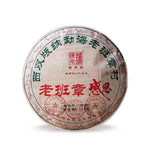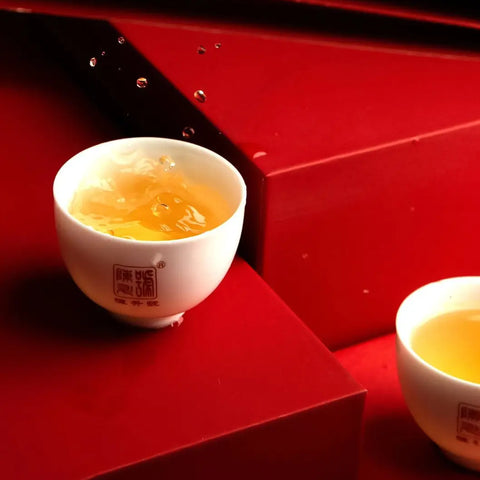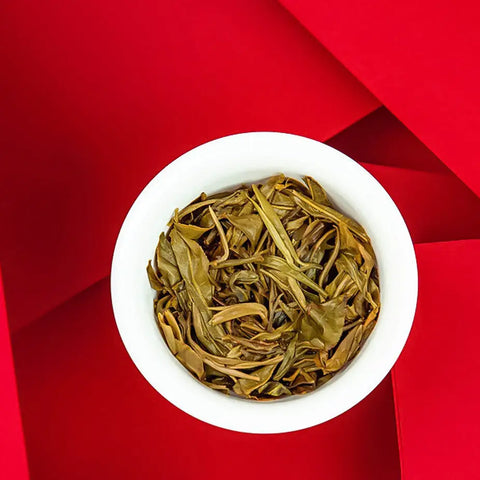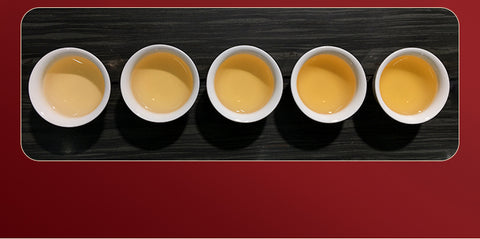How Many Times Can You Steep Pu Erh Tea
Pu-erh tea, originating from China, is prized for its unique aging process and rich flavor. Both raw and ripe varieties offer distinctive tastes and benefits.
Origins and Characteristics
Pu-erh tea comes from Yunnan Province in China. It has a long history dating back over 1,000 years.
The tea leaves are usually larger, known for their distinctive shapes and earthy aroma. This tea undergoes a special fermentation process that can last for months or even years.
Bestsellers

2022 Pu-Erh Tea Sample Box (Free Shipping)

2022 Yi Pin Chen Sheng Raw Pu-erh Tea Sample Box

2022 Lao Ban Zhang Raw Pu-erh Tea

2022 Na Ka Raw Pu-erh Tea

2023 Ban Zhang Yin Xiang Raw Pu-erh Tea

2017 Rong Pu Ripe Pu-erh Tea
With aging, the flavor deepens, becoming smoother and more complex. Raw (Sheng) Pu-erh is greenish and bright, while Ripe (Shou) Pu-erh is darker and richer due to accelerated fermentation.
Types of Pu-erh Tea
There are two main types of Pu-erh tea: Raw (Sheng) and Ripe (Shou). Raw Pu-erh is less processed and retains a more youthful, somewhat grassy flavor.
Ripe Pu-erh undergoes a fermentation process, giving it a deep, earthy taste. Both types are available in cake or loose-leaf form.
Raw Pu-erh is chosen for its vibrant and sharp taste that mellows with age. Ripe Pu-erh, meanwhile, is appreciated for its smoother profile. You can select either based on your preference or health benefits sought.
Steeping Techniques for Pu-erh Tea

The best techniques for steeping Pu-erh tea differ based on tradition and region. Learning these methods will help you achieve optimal flavor and maximize the number of times you can steep the tea.
Traditional Steeping Methods
Using traditional methods, Pu-erh tea is typically steeped with small quantities of water and a higher quantity of leaves. A gaiwan or small Yixing clay pot is often used.
- Rinse the Leaves: Pouring hot water over the tea leaves for a few seconds and discarding the water helps to awaken the leaves.
- Multiple Infusions: Each steep should last only a few seconds initially, gradually increasing the steep time with each infusion.
- Water Temperature: The ideal water temperature ranges from 195°F to 205°F depending on the specific type of Pu-erh.
Employing these techniques can result in 8-10 infusions, each offering a unique taste profile.
Western Steeping Methods
Western methods generally use larger quantities of water and a lower leaf-to-water ratio compared to traditional techniques. Here, you might use a teapot or even an infuser mug.
- Initial Rinse: Similar to traditional methods, a quick rinse is beneficial.
- Longer Infusion Times: Steep the leaves for 2-4 minutes to extract more flavors upfront.
- Water Temperature: Keep the water temperature in the range of 200°F.
With Western methods, you can typically achieve 4-6 good infusions before the flavors start to diminish.
Experimenting with these methods will help you find the perfect balance for your taste preferences.
Determining Steeping Frequency
When steeping Pu Erh tea, factors such as the tea's age, type, and quality can influence how many times you can reuse the leaves. Finding the optimal number of steeps ensures you maximize flavor without oversteeping.
Lao Ban Zhang

2024 Lao Ban Zhang Ripe Pu-erh Tea

2022 Lao Ban Zhang Raw Pu-erh Tea

2023 Ding Feng- Lao Ban Zhang Raw Pu-erh Tea (42g)

2024 Xiao Ban Zhang Raw Pu-erh Tea

2020 Lao Ban Zhang Raw Pu-erh Tea 125g

2025 Lao Ban Zhang -Gan En Raw Pu-erh Tea 357g
Factors Affecting Steepability
Various elements determine how many times you can steep Pu Erh tea. One primary factor is the quality of the tea leaves. High-quality Pu Erh can withstand multiple infusions, sometimes up to 10-12 steeps, while low-quality tea may only endure 3-5.
The type and age of the tea also play crucial roles. Raw (Sheng) Pu Erh and aged tea typically offer more steeps than ripe (Shou) Pu Erh. Another consideration is the steeping method. Using shorter, higher-intensity steeps, like in Gongfu tea preparation, often allows for more steeps compared to Western-style brewing.
Water temperature and steeping time also impact the steeping frequency. Hotter water and longer steep times can extract flavors more quickly but may reduce the total number of steeps. Adjust your method based on your preferences to achieve the best results.
Optimal Number of Steeps
The optimal number of steeps for Pu Erh depends on personal taste and the specific characteristics of the tea. Generally, you can expect 6-8 good quality steeps from an average Pu Erh tea before the flavor significantly diminishes.
For enthusiasts using Gongfu brewing, it’s common to get up to 10-12 infusions. The initial steeps often carry the most robust flavors, with later steeps providing subtler, more nuanced tastes.
To find your preferred number of steeps, begin with shorter infusion times and gradually increase them with each subsequent steep. Taste-testing at different intervals helps determine when the tea starts losing its flavor, allowing you to decide when to stop steeping.
Maximizing Flavor and Potency

To achieve the best flavor and potency from pu-erh tea, it's crucial to adjust water temperature and steep duration properly. Each variable plays a vital role in extracting the right balance of taste and beneficial compounds.
Adjusting Water Temperature
Pu-erh tea is unique in needing varying water temperatures depending on its type. For raw pu-erh, use water around 185°F (85°C). For ripe pu-erh, opt for near-boiling water at about 212°F (100°C).
These temperatures help release the tea's complex flavors. Using too hot water for raw pu-erh can make it bitter. Cooler water for ripe pu-erh may not extract enough flavor. Always measure the water temperature accurately to ensure consistent results.
Steep Duration and Flavor Development
Steep duration affects both flavor and potency. For initial steeps, a brief duration of about 20-30 seconds is ideal. This allows you to appreciate the subtler notes of the tea. Gradually increase the steeping time by 10-15 seconds for each subsequent infusion.
This method helps balance the tea's strength and complexity. Avoid overly long steeping durations, as they can lead to astringency. Monitor each steep closely to find the optimal duration that suits your taste preferences.
Reusing Pu-erh Tea Leaves
Pu-erh tea leaves can be reused multiple times, making them cost-effective and allowing for a deeper exploration of flavors. The number of infusions depends on several factors, including the quality of the leaves and the method used for steeping.
Methods for Multiple Infusions
Gong Fu Style
The Gong Fu method involves using a higher leaf-to-water ratio and shorter steeping times. This allows you to achieve numerous infusions, sometimes up to 10 or more. You start with a rinse to awaken the leaves, then proceed with steeping times starting from a few seconds, gradually increasing with each infusion to extract more flavor. This method is ideal for premium Pu-erh teas, which can sustain many short infusions.
Western Style
Using the Western method, you steep Pu-erh tea leaves in larger teapots with longer steeping times. This approach typically offers 2-4 infusions. Initial steepings last around 3-5 minutes, while subsequent ones may extend up to 7 minutes. This method is convenient for those who prefer fewer but longer infusions and works well for both raw and cooked Pu-erh varieties.
Storage Between Infusions
Proper storage of used leaves is crucial for maintaining flavor during multiple infusions. After each steep, drain the leaves thoroughly to prevent mold. Store them in a cool, shaded area, preferably in an uncovered vessel to allow air circulation. Avoid refrigerating as moisture can affect the leaves' quality. When ready for the next infusion, re-rinse the leaves to refresh them.
Health Benefits and Considerations

Drinking Pu-erh tea offers several nutritional benefits and promotes health, but it’s vital to be aware of safe brewing practices to avoid potential risks.
Nutritional Content Analysis
Pu-erh tea contains a range of beneficial compounds. It is rich in antioxidants, including catechins and flavonoids, which help fight free radicals in your body. Vitamins such as Vitamin C and some B vitamins are present, albeit in small amounts. This tea also contains trace minerals like manganese and fluoride, contributing to bone health and oral hygiene.
Polyphenols in Pu-erh tea contribute to its unique properties. They are known for supporting metabolism and aiding digestion. The presence of these nutrients makes Pu-erh tea a functional beverage that goes beyond simple hydration.
Potential Health Benefits
Drinking Pu-erh tea may support weight management by boosting metabolism. Compounds in the tea can help regulate blood sugar levels, making it a useful drink for those managing diabetes. Studies suggest that regular consumption might reduce LDL cholesterol levels, benefiting cardiovascular health.
This fermented beverage can also aid digestion and promote gut health due to the presence of natural probiotics formed during fermentation. Antibacterial properties may help maintain oral hygiene, preventing cavities and gum disease.
Brewing Safety and Precautions
Brewing Pu-erh tea requires some caution. Always use water at the right temperature, typically 195-205°F (90-96°C), to avoid extracting unwanted bitter compounds. Avoid over-steeping to prevent the release of excessive tannins, which could cause digestive issues.
Make sure to source your Pu-erh tea from reputable suppliers to avoid contaminants like pesticides. Stay aware of your caffeine intake, especially if you’re sensitive, as Pu-erh tea can have moderate caffeine levels. Avoid drinking excessively, especially if you're pregnant or have specific health conditions.
Proper Storage for Repeated Use

Ensuring proper storage can maintain the quality and flavor of your Pu Erh tea across multiple steeps. Pay attention to the environment and containers you use.
Preserving Freshness and Flavor
Store Pu Erh tea in a cool, dry place away from direct sunlight. Humidity can cause mold growth, while exposure to light may degrade its quality.
Airflow is essential but should be minimized to prevent the tea from absorbing odors. Use breathable materials such as cloth or paper wrapping instead of airtight containers.
Temperature consistency is key. Large fluctuations can negatively impact the tea's aging process. Aim for stable conditions around 20°C (68°F).
Containers and Environment
Opt for containers made of porous materials like clay or unglazed ceramics. These allow the tea to breathe while protecting it from external odors.
Avoid plastic or metal containers. These materials can impart unwanted flavors and do not breathe.
Dedicated tea cabinets or chests can further help. Ensure they are kept clean and dry, free from strong odors.
Proper labeling is useful. Note the date of purchase and type of tea to track its aging process.
Cultural Significance of Pu-erh Tea
Pu-erh tea is deeply intertwined with cultural traditions, from age-old customs to contemporary practices. You will find that whether in historical contexts or modern settings, pu-erh tea holds a revered place in society.
Historical Practices
Historically, pu-erh tea is rooted in the rich traditions of Yunnan, China. It has been a vital part of Chinese tea culture for centuries. Emperors and nobility highly prized this tea, often utilizing it in important ceremonies and as a symbol of wealth and honor.
Pu-erh tea bricks were once used as a form of currency and traded along the ancient Tea Horse Road. The production methods for this tea were closely guarded secrets. Artisans and tea masters passed down their knowledge through generations, ensuring the preservation of its unique qualities.
Ancient texts and folklore often reference pu-erh tea, signifying its deep cultural resonance. From medicinal uses to its role in social functions, pu-erh tea's significance permeates various aspects of life and history.
Modern Rituals
In modern times, pu-erh tea continues to be cherished, albeit in different forms. Tea aficionados appreciate its complex flavors through repeated steepings, a practice that emphasizes patience and mindfulness.
You may find pu-erh tea served at both formal tea ceremonies and informal gatherings. This tea is celebrated for its aging potential, much like fine wine. Collectors often seek out well-aged pu-erh for special occasions or personal enjoyment.
Tea houses and specialty shops frequently host pu-erh tasting events, allowing enthusiasts to explore its diverse profiles. Its cultural importance has evolved, yet remains deeply influential, bridging the gap between tradition and contemporary lifestyles.
← Older post Newer post →
